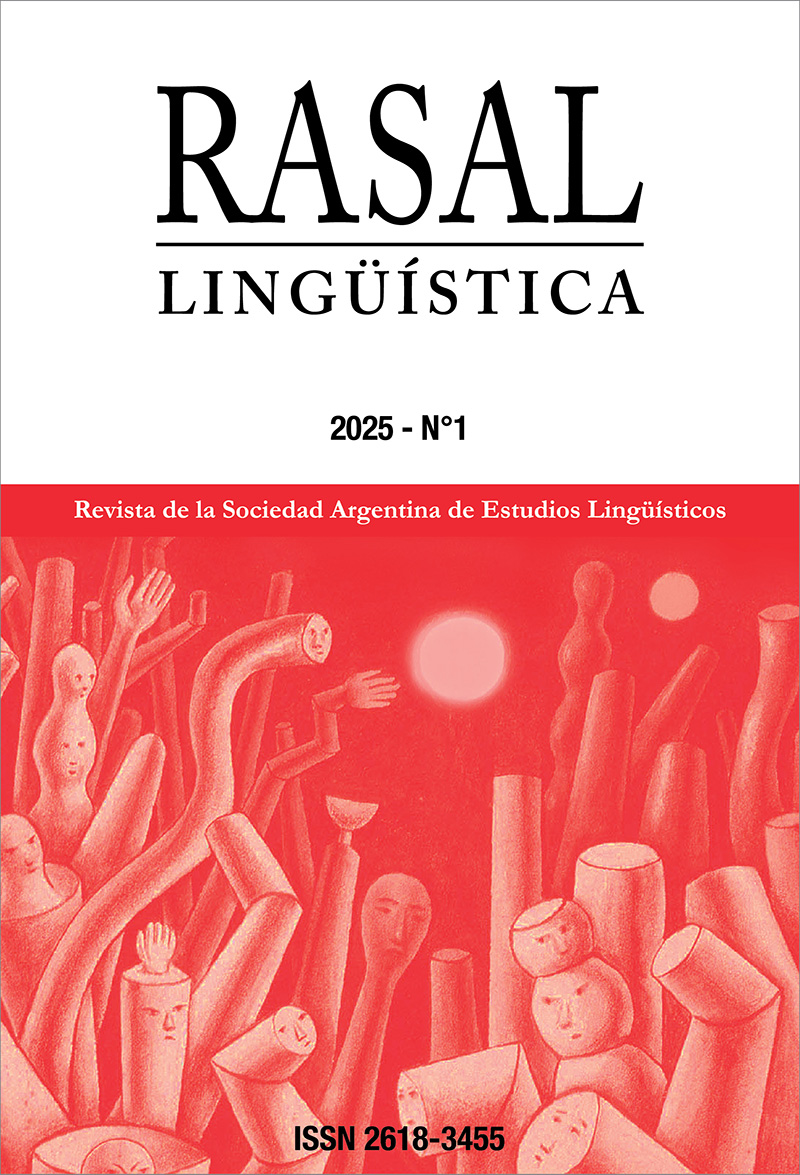Neologisms in Paraguayan Guarani
DOI:
https://doi.org/10.56683/rs251140Keywords:
neologisms, word formation, lexical semantics, lexicography, Paraguayan GuaraniAbstract
Paraguayan Guarani is a language of great vitality that, as a result of its officialization in Paraguay, has made its way into new usage environments, giving rise to ample lexical innovations. In this paper, we present an overview of neologisms in the language focusing on the word formation devices used and the most frequent types of semantic shift. More precisely, we analyze multiple neologisms from three large domains (health, education, the media and technology) and other minor domains that have seen new lexical items coined. Also, we address the lexicographic representation of neologisms, for which we include a survey looking at the extent and ways in which neologisms are presented in dictionaries.
Downloads
References
Adelstein, A. (2022). Neología y semántica: grados de neologicidad en el ámbito nominal. En E. Bernal, J. Freixa Aymerich, S. Torner Castells (Eds.), La neología del español (pp. 327-345). Iberoamericana/Vervuert.
Adelstein, A., Berri, M. y Boschiroli, V. de los A. (2021). Los diccionarios: la representación del léxico. En G. Ciapuscio y A. Adelstein (Eds.), La lingüística. Una introducción a sus principales preguntas (pp. 433-472). Eudeba.
Adelstein, A. y Kuguel, I. (2008). De salariazo a corralito, de carapintada a blog. Nuevas palabras en veinticinco años de democracia. Universidad Nacional de General Sarmiento/Biblioteca Nacional.
Avellana, A y Estigarribia, B. (2023). El español en Paraguay. En F. Moreno Fernández y R. Caravedo (Eds.), Dialectología hispánica. The Routledge Handbook of Spanish Dialectology (pp. 319-332). Routledge.
Bittar Prieto, J. (2021). Spanish-Origin Verbal and Grammatical Borrowing in Paraguayan Guaraní. [Tesis de Doctorado, University of New Mexico]. https://digitalrepository.unm.edu/ling_etds/73
Canese, A., Krivoshein de Canese, N. y Acosta Alcaraz, F. (2015). Guaraní para uso médico. EFACIM.
Comrie, B. (2013). Numeral Bases. En M. Dryer y M. Haspelmath (Eds.), World Atlas of Language Structures Online (v2020.3). http://wals.info/chapter/131
Estigarribia, B. (2017). A grammar sketch of Paraguayan Guarani. En B. Estigarribia y J. Pinta (Eds.), Guarani Linguistics in the Twentieth Century (pp. 7-85). Brill.
Estigarribia, B. (2020). A Grammar of Paraguayan Guarani. UCL Press.
Freixa, J. (2022). El proceso neológico. En E. Bernal, J. Freixa Aymerich y S. Torner Castells (Eds.), La neología del español (pp. 51-72). Iberoamericana/Vervuert.The Oxford Handbook of Polysynthesis
Fundación Yvy Marãe’ỹ y Consejo Nacional de Ciencia y Tecnología (2017). Oñembyaty guarani ñe’ẽndy oĩhaguéicha ha oñemoheñói ñe’ẽpyahu ojeporúva informática ha ñanduti-pe. Arandurã Editorial.The Oxford Handbook of Polysynthesis
González, H. (2007). Formación de palabras y neologismos en tapiete (tupí-guaraní). El caso de la incorporación nominal. Signo y Seña, 17, 193-225.The Oxford Handbook of Polysynthesis
Gregores, E. y Suárez, J. (1967). A Description of Colloquial Guarani. Mouton.The Oxford Handbook of Polysynthesis
Guasch, A. (1997). El idioma guaraní. Gramática y antología en prosa y verso. CEPAG.The Oxford Handbook of Polysynthesis
Ministerio de Educación y Culto (1995). Ñane Irũ. Serie Arandu.The Oxford Handbook of Polysynthesis
Ministerio de Educación y Cultura (2011). Cuadernillo de trabajo para el/la estudiante. Comunicación Momarandu. EMASA.The Oxford Handbook of Polysynthesis
Mithun, M. (2017). Argument marking in the polysynthetic verb and its implications. En M. Fortescue, M. Mithun y N. Evans (Eds.), The Oxford Handbook of Polysynthesis (pp. 30-58). Oxford University Press.The Oxford Handbook of Polysynthesis
Montoya, A. (2011 [1639]). Tesoro de la lengua guaraní. CEPAG.The Oxford Handbook of Polysynthesis
Palacios Alcaine, A. (2008). Paraguay. En A. Palacios Alcaine (Ed.), El español de América. Contactos lingüísticos en Hispanoamérica (pp. 279-300). Ariel.
Peralta, E. (2018). El quehacer lexicográfico bilingüe español-guaraní: estado del arte en el Paraguay. Revista Científica de la UCSA, 5(1), 25-40.
Pinta, J. y Smith, J. L. (2017). Spanish loans and evidence for stratification in the Guarani lexicon. En B. Estigarribia y J. Pinta (Eds.), Guarani Linguistics in the Twentieth Century (pp. 285-314). Brill.
Rodrigues, A. (1984/85). Relações internas na família lingüística tupí-guaraní. Revista de Antropología, 27/28, 33-53.
Schmid, H. J. (2008). New words in the mind: Concept-formation and entrenchment of neologisms. Anglia, 1, 1-36.
Stewart, A. (2017). Jopara and the Spanish-Guarani language continuum in Paraguay: Considerations in linguistics, education, and literature. En B. Estigarribia y J. Pinta (Eds.), Guarani Linguistics in the Twentieth Century (pp. 379-416). Brill.
Thompson, S. (2004). Property concepts. En G. Booij, C. Lehmann, J. Mugdan, W. Kesselheim y S. Skopeteas (Eds.), Morphology. An International Handbook on Inflection and Word-Formation, Vol. II (pp. 1111-1116). De Gruyter.
Velázquez-Castillo, M. (1996). The Grammar of Possession: Inalienability, Incorporation and Possessor Ascension in Guaraní. John Benjamins.
Velázquez-Castillo, M. (2004). Guaraní (Tupí-Guaraní). En G. Booij, C. Lehmann, J. Mugdan, W. Kesselheim y S. Skopeteas (Eds.), Morphology. An International Handbook on Inflection and Word-Formation, Vol. II (pp. 1421–1432). De Gruyter.
Villena Araya, B. (2014). Creación neológica en mapudungún: entre el desplazamiento y la lealtad lingüística. Terminàlia, 10, 37-49.
Published
How to Cite
Issue
Section
License
Copyright (c) 2025 Martín Califa, Verónica Gómez

This work is licensed under a Creative Commons Attribution-NonCommercial 4.0 International License.
RASAL © Algunos derechos reservados










